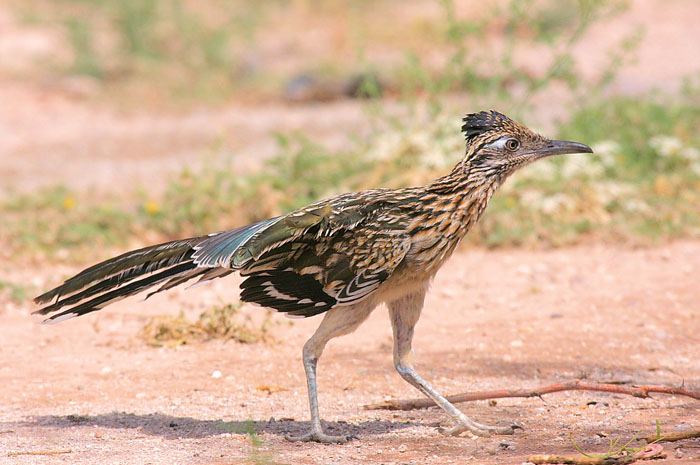
New Mexico is one of the most exciting states for birdwatching! The birds of New Mexico include 551 species that thrive in scenic mountain forests, vital wetlands, peaceful meadows, and other bird-rich habitats.
There are stunners like the shining Rivoli’s Hummingbird, the fast-flying Prairie Falcon, elusive rosy-finches, the lovely House Finch, and much more!
How many birds in New Mexico have you seen? With more than 550 species to choose from, we bet you’ve seen a lot! But how many could you identify?
This list showing the most common backyard and wild birds in New Mexico will help!
Most Common Birds of New Mexico
New Mexico is a haven for birds, but which species are most common?
To make the best list of common New Mexico birds, we reviewed eBird data from 2021 to 2023 and arranged species from the most common to least common.
PS! The species on the bottom of the list are common birds too!
To help with identifying these common birds of New Mexico, we also included up to date information about their behavior and field marks.
House Finch
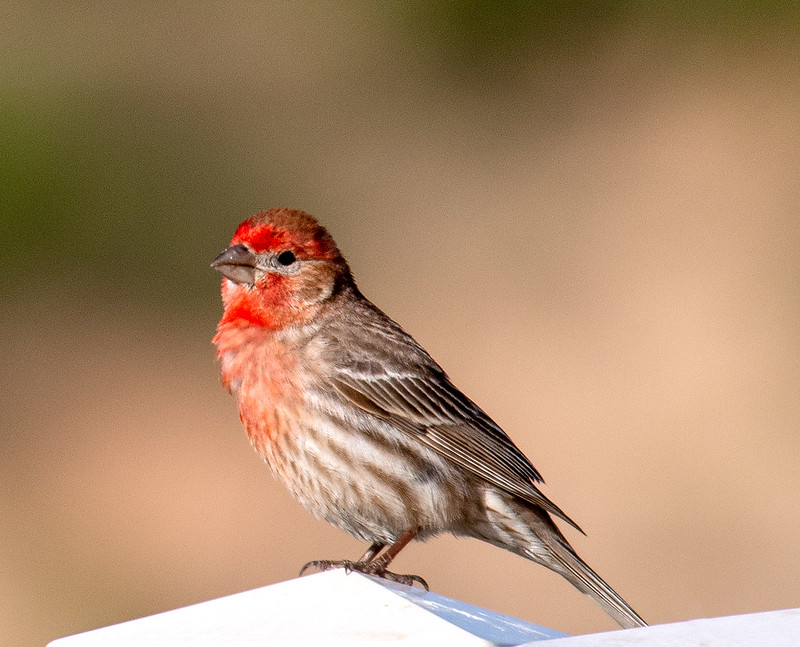
Photograph © John Hansen
Scientific name: Haemorhous mexicanus
Length: 6 inches
Weight: .88 ounces
Wingspan: 10 inches
Song: “chip,chip,chiprididip,ZREEYachip”
House Finches are sparrow-sized birds with dark, rounded beaks and fairly long wings. Males are orange-red or rose-red on their head, throat and breast, and have some red on their rump. They also have brownish streaks on their back, flanks, and white belly.
Like the male, female House Finches have two white wing bars on long, gray-brown wings. However, they lack red and are mostly streaked, dull brown-gray birds.
House Finches feed on seeds, buds, fruit, and flowers. They often visit feeders in New Mexico but also forage on the ground, and in bushes and trees.
We see these pretty birds in deserts and arid zones, and in parks, farmland, urban areas, and other semi-open habitats.
The House Finch makes a soft cup nest built on a tree, building ledge or other spot with some overhanging cover. They often occur in small groups and live in southern Canada, most of the USA, Mexico, and Hawaii.
Key Identifications:
- Reddish or plain gray-brown, streaked, sparrow-like bird.
- Eats seeds, flowers, buds, and fruit. Can visit feeders but also forages on the ground and in bushes and trees.
- Makes a soft cup nest in trees, on building ledges, and other places.
- The House Finch often makes a soft, “fidip” call. Males also sing a warbling song from prominent, high perches. It sounds like, “chip,chip,chiprididip,ZREEYachip”.
House Finches are sparrow-like, reddish or brownish, streaked birds. They live in arid zones as well as in parks and urban areas. All of the millions of House Finches that live east of the Rocky Mountains are descendants of birds released on Long Island in 1939.
American Robin

Scientific name: Turdus migratorius
Length: 10 inches
Weight: 2.7 ounces
Wingspan: 17 inches
Song: “cheery, cheery, cheery, cheery, cheer, cheer”
The American Robin is a familiar and common thrush that is dark gray above and brick red below. It also has an orange-yellow bill, a blackish head with white markings around the eyes and on the throat, and a white belly.
Both sexes of this thrush species are similar but males are darker above and more reddish on the underparts. Young American Robins have more white marks on their faces and spotting on orange underparts.
In flight, this common thrush in New Mexico also shows white corners in its outer tail feathers.
American Robins forage on the ground for worms, insects, snails, and other small creatures. In winter, these common birds flock together and perch in trees and bushes to eat berries and fruit.
The American Robin makes a cup nest in trees and lives in parks, woodlands, towns, and many other habitats. They reside in Alaska, most of Canada, the USA and in Mexico.
Key Identifications:
- Fair-sized songbird that is dark gray above, and brick red and white below.
- Forages for worms and bugs on lawns and other open grassy areas, also flocks together to feed on fruiting trees in the winter.
- Makes a cup nest in trees.
- The American Robin is quite vocal and makes a loud, sharp, “yenk!” call and quieter “check,check,check” calls. It also has a lovely cheerful song of caroled phrases, “cheery, cheery, cheery, cheery, cheer, cheer”.
With an estimated population of 370 million, the American Robin is considered to be the most numerous landbird in North America.
Mourning Dove
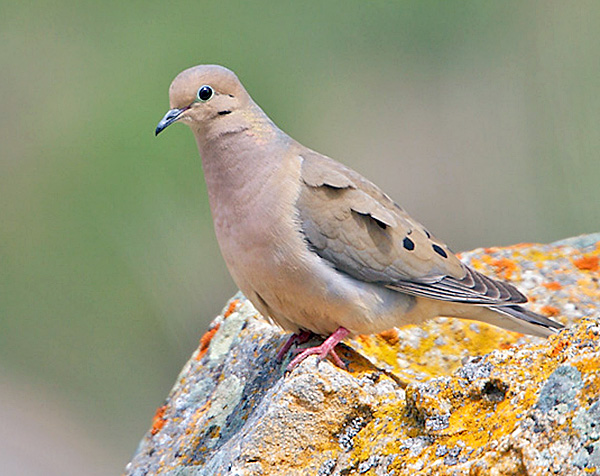
Photograph © Greg Lavaty.
Scientific name: Zenaida macroura
Length: 12 inches
Weight: 4.2 ounces
Wingspan: 18 inches
Song: “hooOOA, hoo, hoo, hoo”
Mourning Doves are medium-sized, grayish-brown doves with long tails. They have small black spots on their wings and a small head with a slender, dark beak.
Males and females also have narrow gray eyerings, a black mark on the face, and pale iridescent gold on the sides of their necks. They look alike except for males having more gray on the head and neck, and more iridescence.
This dove has fairly long wings and swift, direct flight. When flying, it shows black and white in its tail.
The Mourning Dove occurs in woodlands, gardens, on farms, and in urban areas. This common feeder visitor eats seeds and grains. It also forages in open situations, picking food from the ground.
This pleasant dove species can visit a feeder on its own or forage in small flocks. It builds an unkempt stick nest in bushes and trees and is very common throughout the USA, southern Canada, and Mexico.
Key Identifications:
- Plain brown and gray dove with a long, pointed tail.
- Feeds on seeds at feeders and on the ground in open areas.
- Makes a small, messy nest of sticks in trees.
- Sings a sad and owl-like “hooOOA, hoo, hoo, hoo”.
The Mourning Dove is the common garden dove in most of its range. It often visits feeders and its cooing song is commonly mistake for an owl. This species has a short lifespan with many adults only living for a couple of years or less.
White-winged Dove
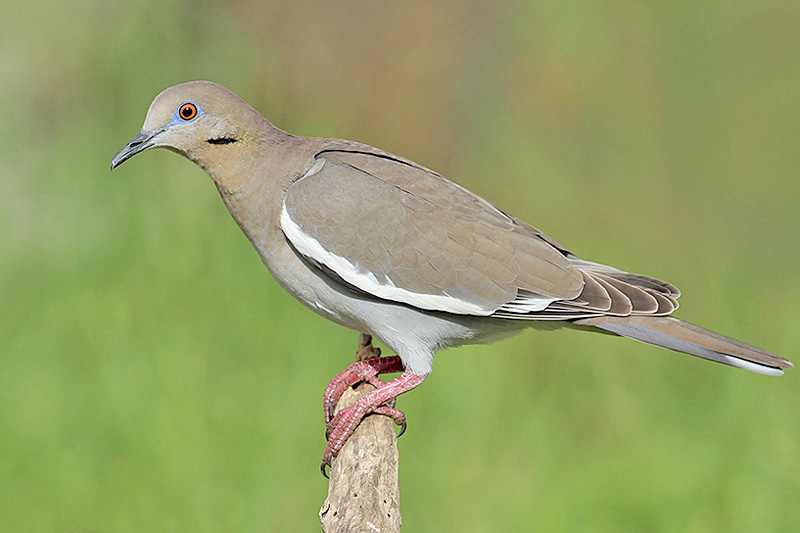
Scientific name: Zenaida asiatica
Length: 121.5inches
Weight: 5 ounces
Wingspan: 19 inches
Song: “hrrHOOP, who, hroo”
White-winged Doves are sandy brownish and gray doves with rectangular tails. They have a white patch in each wing, a white tail tip, and a dark, slender beak.
Males and females look similar and have blueish eyerings and orange-red eyes. They have a black mark on the lower side of the face and reddish legs and feet.
White-winged Doves have fairly long wings and can fly long distances in quick, direct flight. When flying and perched, the underside of its tail looks black with a broad white tip.
The White-winged Dove lives in gardens, urban areas, farmlands, and other semi-open habitats. It mostly feeds on seeds and grain that it picks up from the ground in farm fields and many other open situations.
This easily seen dove species usually forages in groups and can form large flocks. They make messy stick nests in trees and, in the USA, are mostly found in Texas west to parts of southern California.
Key Identifications:
- Gray and pale brown dove with white in its wings and a rectangular tail with a black and white tip.
- Occurs in semi-open habitats where it forages on the ground for grain and seeds.
- Builds a small, messy stick nest in trees.
- Sings a classic, cooing dove song “hrrHOOP, who, hroo”.
The White-winged Dove is common, easily seen, and may be spreading north. It feeds on the ground and often occurs in flocks. This species gets most of its water from cactus fruits but, when needed, can fly 25 miles in search of a water source.
Common Raven
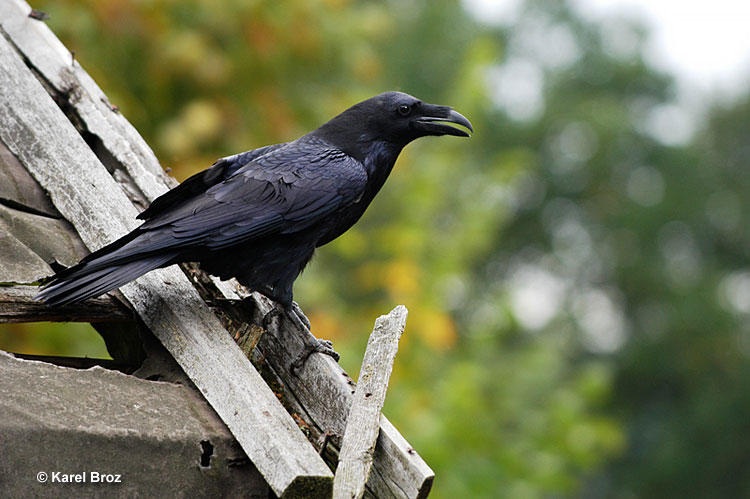
Scientific name: Corvus corax
Length: 24 inches
Weight: 2.6 pounds
Wingspan: 53 inches
Song: “Grauk Grauk Grauk Grauk!”
The Common Raven is a big, black crow-like bird with long, broad wings and a broad, wedge-shaped tail.
Both sexes look alike and have feathers extending onto the top part of their strong, stout beaks.
This bird is often seen in soaring flight or in direct flight where it gives a few strong flaps between glides.
Common Ravens are omnivores that feed on carrion, small animals, nesting birds, and various other food items. They forage by flying above roads and other places and are always on the lookout for feeding opportunities.
This big Corvid makes a big, bulky nest out of sticks and lines the shallow cup with mud, wool, and other items. It builds its nest on a cliff, tree, bridge, or other structure.
The Common Raven lives in wilderness areas from the Arctic to parts of the northeastern USA and the western USA. In some places, it lives in urban areas. Common Ravens are some of the most common birds of New Mexico.
Key Identifications:
- Huge, black, crow-like bird with a strong, stout beak and a wedge-shaped tail.
- An omnivore that feeds on small animals, carrion, and other food items.
- Makes a big bulky stick nest in trees, on cliffs, and on human-made structures.
- Common Ravens are vocal birds. One of their most common calls is a load and croaking, “Grauk Grauk Grauk Grauk!”.
Common Ravens live in mountains, forests, tundra, and other wild areas. Some also live near people and, in flight, they can sometimes be mistaken for raptors. However, no hawk species is entirely black with a wedge-shaped tail. The Common Raven can mimic human speech and is one of the most intelligent bird species.
Spotted Towhee
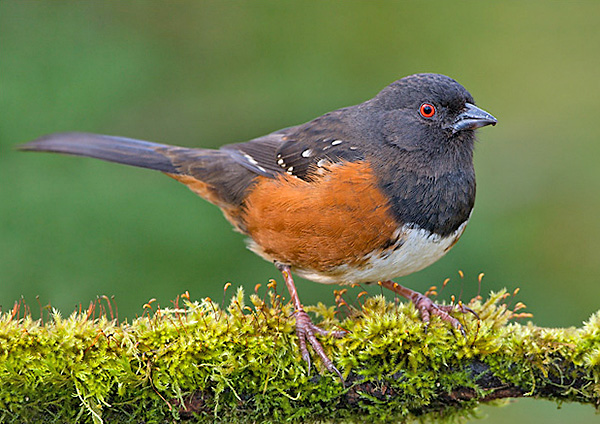
Photograph © Glenn Bartley.
Scientific name: Pipilo maculatus
Length: 8.5 inches
Weight: 1.4 ounces
Wingspan: 10.5 inches
Song: “two two two chreee!”
The Spotted Towhee is a thrush-sized, colorful, sparrow-like bird with reddish eyes and a black, finch-like beak. It has black upperparts with some small white spots, a black hood, and a white belly with chestnut flanks.
It also has a buff undertail, and white spots on the underside of its longish, rounded tail. Both sexes look similar but the female has a grayish-brown head. Juveniles are like dark brown, streaked sparrows with white in their tails, two buff wing bars, and a buff undertail.
Spotted Towhees find insects and seeds by using both feet to scratch and toss leaf litter. This bird also eats berries in bushes, especially in winter.
This species makes an open cup nest out of grass and other plant matter in dense vegetation, near or on the ground.
The Spotted Towhee lives in shrubby habitats from Manitoba and the Dakotas west to the coast. In winter they range east to Kansas and south to Texas.
Key Identifications:
- Medium-sized, colorful songbird with a black hood, white spotting on black upperparts, and chestnut flanks.
- Forages on the ground for insects and seeds in leaf litter in shrubby habitats.
- Makes an open cup nest in dense vegetation, on or near the ground.
- Often calls and makes a nasal, cat-like call, “rheyeah”, and sings a short trilled song, “two two two chreee!”
Spotted Towhees are thrush-sized black and white birds with chestnut flanks and white spotting on their wings and/or back. They occur in pairs that forage for insects and seeds in leaf litter. When female Spotted Towhees are disturbed on their nests, instead of flying away, they distract predators by running away.
Northern Flicker
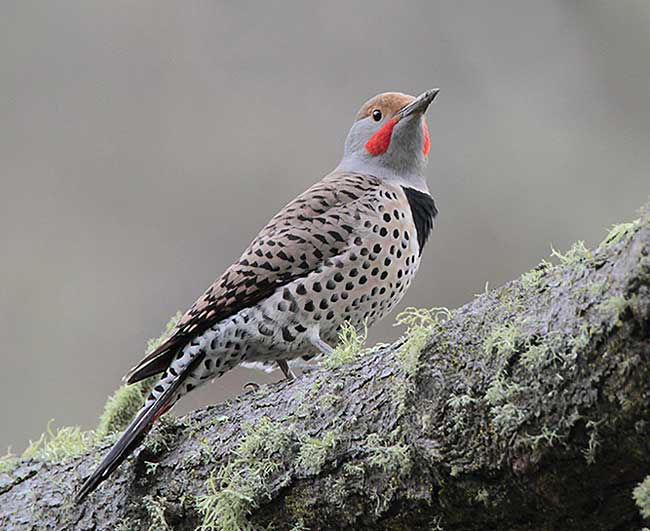
Scientific name: Colaptes auratus
Length: 12.5 inches
Weight: 4.6 ounces
Wingspan: 20 inches
Song: “kick,kick,kik,kik,kik.kik.kik.kik.kik.kik.kik.kik!”
Northern Flickers are fairly large, tan and gray woodpeckers with barring on their backs. They have a black mark on their breast, black spotting below, and a dark, stout beak.
Males in the east have a tawny throat and face with a black moustache and small red spot on the back of their heads. Males in the west have mostly gray heads with a red moustache.
Female Northern Flickers look like males but lack the moustache mark.
In bounding flight, they have white rumps and flash color on their underwings. This is bright yellow in eastern birds and reddish in flickers west of the Rocky Mountains.
This woodpecker eats many ants and other insects that it catches on the ground. It forages by flying to the ground, locating anthills, and lapping them up with its long tongue.
Northern Flickers nest in tree cavities and live in wooded and open habitats in Canada, the USA, and Mexico.
Key Identifications:
- Tan and gray woodpecker with black barring above, black marks below, and a bright, white rump.
- Forages for ants and other insects on the ground.
- Nests in tree cavities.
- A vocal woodpecker, the Northern Flicker often gives loud, “flicka,flicka,flicka” calls, and another loud, single note that sounds like, “Keer!” They also have a long, laughing vocalization of repeated notes, “kick,kick,kik,kik,kik.kik.kik.kik.kik.kik.kik.kik!”.
Northern Flickers are common and have earned the title of being the state bird of Alabama. They mostly forage for ants on the ground in open and wooded areas. The red-shafted Northern Flickers in the west used to be considered a separate species from the yellow-shafted flickers of the east. At present, they are considered to be one species because they frequently hybridize with each other.
Dark-eyed Junco
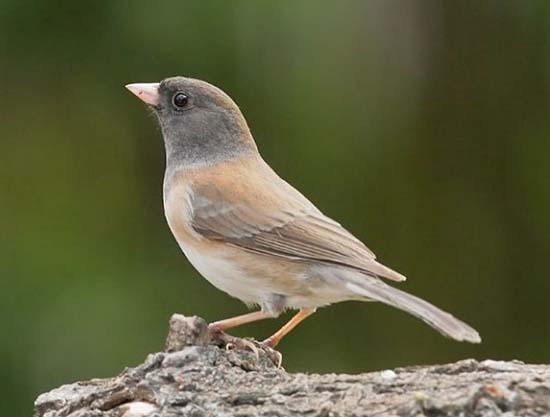
Scientific name: Junco hyemalis
Length: 6.25 inches
Weight: .67 ounces
Wingspan: 9.25 inches
Song: “sipsipsipsipsipsipsip”
Dark-eyed Juncos are sparrow-like birds with pale conical bills and dark eyes. This small bird has variable plumage with most being slate gray or gray and brown with white on their bellies, and white under their tails.
Other plumages include birds with dark masks and faint white wing bars, juncos with pale gray hoods and pinkish sides, and birds with blackish hoods and chestnut sides.
In flight, all Dark-eyed Juncos show extensive white in their longish tails.
This species feeds on seeds, insects, and some fruit and grain. Juncos forage on the ground in wooded areas, parks, and other habitats. They also feed on fallen seed beneath feeders.
They build cup nests on the ground under fallen logs, in roots, and other hidden spots. After breeding, juncos form flocks that forage together in similar wooded and semi-open habitats.
Dark-eyed Juncos are common birds in Canada, the USA, and parts of Mexico.
Key Identifications:
- Sparrow-like gray and brown bird with dark eyes, a pale beak, and white in the tail.
- Forages for seeds and insects on the ground, can feed on seeds at and beneath feeders.
- Builds a cup-shaped nest on the ground in tree roots, under logs, and other hidden places.
- This species often makes a sharp, high-pitched chip note, “pik!”. On breeding grounds, males sing a short, plain trill, “sipsipsipsipsipsipsip”.
Dark-eyed Juncos are sparrow-like, gray and brown birds with much white in the tail. Common wintering birds in many areas, they forage for seeds on the ground in wooded and park-like habitats. In many places, this common species is also known the “Snowbird” on account of only occurring in the winter months and having white on the belly and tail.
Lesser Goldfinch
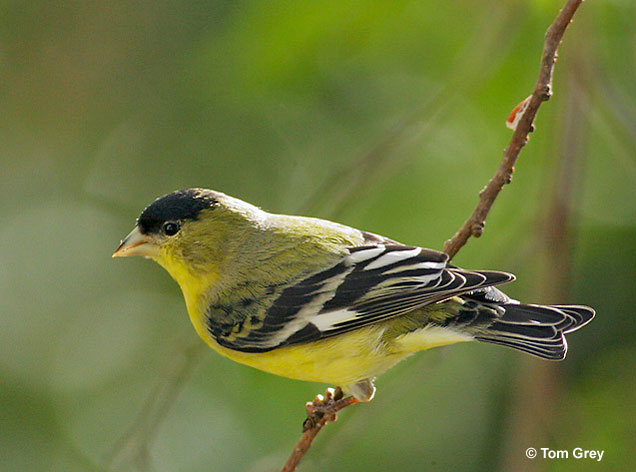
Scientific name: Carduelis psaltria
Length: 4.5 inches
Weight: .3 ounces
Wingspan: 8 inches
Song: “chip idid see sipachupchipchipasipsipchipadip”
The Lesser Goldfinch is a small bird with a grayish, finch-like beak, rather short, forked tail, and long blackish wings with white markings.
Males have a black cap, olive gray-green upperparts, and yellow underparts. Birds that live east of the Rockies have completely black backs. Females are much plainer and are pale brown-olive above and yellow below.
Lesser Goldfinches have quick, bounding flight. They can occur as pairs but, in California and the American southwest, often form sizeable flocks.
This species feeds on a variety of seeds. They often occur in groups with other seed-eating birds as they forage in weedy fields and visit feeders. Lesser Goldfinches pick up seeds from the ground and while perched on stalks of grass-like plants.
The Lesser Goldfinch uses plant fibers to make a small cup nest in a tree.
This species lives in brushy and semi-open woodlands in New Mexico and the American southwest north to southern Washington.
Key Identifications:
- Small finch with olive or black upperparts, yellow underparts, a dark beak, and a small white patch in the wing.
- Forages for seeds on and near the ground and also visits feeders.
- Makes a small cup nest out of grass and other plant matter.
- This species makes clear, high-pitched calls and has a jumbling, tinkling song with warbled and trilled notes, “chip idid see sipachupchipchipasipsipchipadip”.
The Lesser Goldfinch is a small, yellow and olive or black finch with white in their wings and a dark beak. It occurs in brushy habitats and open woodlands, visits feeders, and is most common in California and the American southwest. This species waits for thistle and plenty of other “weedy” plants to have seeds before it builds its nest.
House Sparrow
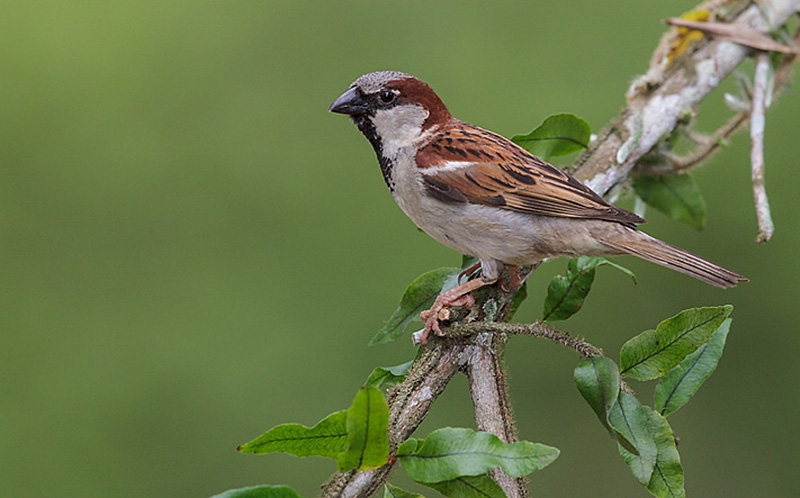
Scientific name: Passer domesticus
Length: 6.25 inches
Weight: .98 ounces
Wingspan: 9.5 inches
Song: “see,chirrup,see,chirrup,see,chirrup”
House Sparrows are small, plump gray and brown birds with conical, finch-like beaks. Males have a gray and rufous head with pale cheeks, and black near their eyes and on their throat.
The rest of their underparts are gray and they have brown, streaked backs with rufous highlights. They also have a white mark in the shoulder of each wing and a grayish rump and tail.
Females are plainer brown and buff, have paler beaks, and buff eyebrows.
House Sparrows feed on seeds, grain, and insects. They are regular visitors to bird feeders and often dominate other smaller species. They also forage on the ground in farmlands, parks, urban areas, and other open situations.
The House Sparrow nests in cavities. When searching for suitable nesting sites, they can kill and remove the eggs and young of smaller species like Eastern Bluebirds.
House Sparrows usually live near people and occur in most of North America, making it one of the most common birds of New Mexico.
Key Identifications:
- Brown and gray sparrow with a bold pattern on its head.
- Feeds on seeds, grain, and insects at feeders and on the ground in urban areas and farmlands.
- Nests in tree cavities, including nest boxes.
- This species is vocal and often makes short chirping calls. Its song is a friendly series of chirping sounds, “see,chirrup,see,chirrup,see,chirrup”.
In many places, the House Sparrow is the common urban sparrow. It occurs in pairs and small groups that forage on sidewalks, in parking lots, farm fields, and other familiar places. This species is one of the very few birds that has evolved to live with people and digest the same grains that we eat.
American Crow
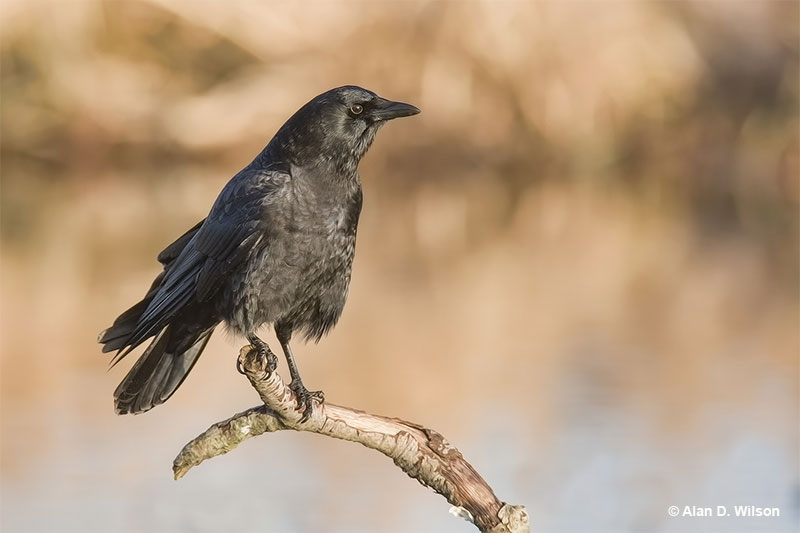
Scientific name: Corvus brachyrhynchos
Length: 17.5 inches
Weight: 1 pound
Wingspan: 39 inches
Song: “Caw! Caw!”
The American Crow is a big, all black bird with a strong, stout bill. In certain lighting, it can have metallic purple and blue iridescence.
Both sexes look the same and have some feathering on their beaks, long, broad wings, and a broad tail.
American Crows have direct flight with strong, steady wing beats. Crows are very social and intelligent birds that are usually seen in flocks. They forage together on the ground or in trees and eat just about anything they can find.
Some of their more regular foods include carrion, fruit, nuts, seeds, insects, and small animals. Like most jays and crow species, they also eat the eggs and nestlings of other bird species.
This species builds bulky stick nests high in trees and lives in most habitats except for high mountains and arid zones.
The American Crow occurs in southern Alaska and much of Canada and the USA.
Key Identifications:
- Big, all black bird with long, broad wing and a broad tail.
- Forages for carrion, fruit, seeds, insects, and small animals.
- Builds a bulky stick nest high in a tree.
- American Crows are very vocal birds. They can make several calls but their most common one is, “Caw! Caw! Caw!”.
The American Crow is a common, large black bird that frequently calls, “Caw! Caw! Caw!”. It usually occurs in flocks and lives in all sorts of places, even urban zones. These birds are very smart and have funerals or wakes! When a crow dies, other crows mark the occasion by gathering together and loudly calling.
White-crowned Sparrow

Scientific name: Zenaida asiatica
Length: 121.5inches
Weight: 5 ounces
Wingspan: 19 inches
Song: “hrrHOOP, who, hroo”
White-winged Doves are sandy brownish and gray doves with rectangular tails. They have a white patch in each wing, a white tail tip, and a dark, slender beak.
Males and females look similar and have blueish eyerings and orange-red eyes. They have a black mark on the lower side of the face and reddish legs and feet.
White-winged Doves have fairly long wings and can fly long distances in quick, direct flight. When flying and perched, the underside of its tail looks black with a broad white tip.
The White-winged Dove lives in gardens, urban areas, farmlands, and other semi-open habitats. It mostly feeds on seeds and grain that it picks up from the ground in farm fields and many other open situations.
This easily seen dove species usually forages in groups and can form large flocks. They make messy stick nests in trees and, in the USA, are mostly found in Texas west to parts of southern California.
Key Identifications:
- Gray and pale brown dove with white in its wings and a rectangular tail with a black and white tip.
- Occurs in semi-open habitats where it forages on the ground for grain and seeds.
- Builds a small, messy stick nest in trees.
- Sings a classic, cooing dove song “hrrHOOP, who, hroo”.
The White-winged Dove is common, easily seen, and may be spreading north. It feeds on the ground and often occurs in flocks. This species gets most of its water from cactus fruits but, when needed, can fly 25 miles in search of a water source.
Woodhouse’s Scrub-Jay
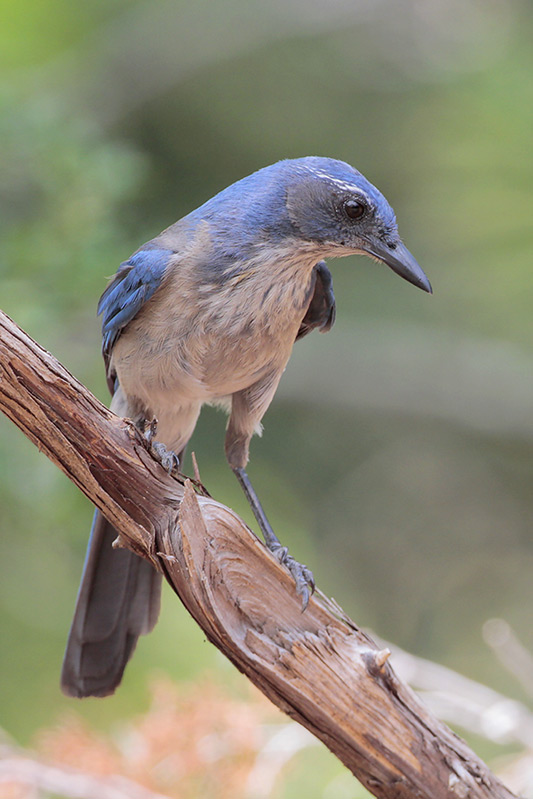
Scientific name: Aphelocoma woodhouseii
Length: 11.5 inches
Weight: 3 ounces
Wingspan: 5.15 inches
Song: “rheeuh”
The Woodhouse’s Scrub-Jay is a medium to large blue and gray jay with a strong, dark beak.
Both sexes are similar and can have a bit of white above their eyes. They also have a dull white throat and a dusky gray face.
This species has a fairly long tail, rounded wings, and rather long, black legs and feet.
Young birds look like adults but have less blue, have more gray on their heads, and more uniform gray underparts.
The Woodhouse’s Scrub-Jay is an omnivore that eats arthropods and many other small creatures. It also feeds on pinyon seeds, and the seeds of various other trees. Small flocks pick food from bark, foliage, and the ground.
This species makes a cup nest of sticks in a dense bush or short tree. We find Woodhouse’s Scrub-Jays in pinyon-juniper woodlands and other scrubby habitats from southern Idaho to central Texas and Mexico.
Key Identifications:
- Medium to large, dull blue and gray jay.
- Forages on and near the ground in scrubby habitats.
- Builds a cup nest of sticks in dense vegetation.
- Makes a rising, nasal, “rheeuh”, and nasal rattling calls.
The Woodhouse’s Scrub-Jay is a dull blue and gray jay with a dull white throat. It lives in scrubby habitats in the “Great Basin” area and parts of the Rocky Mountains. Mule Deers often let this species stand on their backs to remove ticks and other parasites.
White-breasted Nuthatch
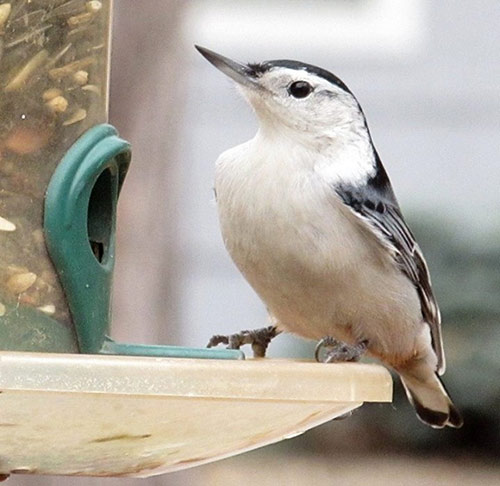
Scientific name: Sitta carolinensis
Length: 5.75 inches
Weight: .74 ounces
Wingspan: 11 inches
Song: “wehn wehn wehn wehn wehn wehn wehn wehn”
The White-breasted Nuthatch is a sparrow-sized bird with a longish, sharp, slightly upturned beak and a short black and white tail. It also has long wings, is mostly blue-gray above, and white and gray below with some chestnut on its belly and undertail.
Both sexes look similar and have a white face but males have a black cap and nape. Females have gray on their head and nape.
This small bird forages for insects, nuts, and seeds by creeping along branches and going down trunks, head-first. It uses its beak to pick food items from bark and also visits feeders.
The White-breasted Nuthatch makes a cup nest out of grass and soft bark inside a tree cavity or nest box.
White-breasted Nuthatches live in various wooded habitats in parts of southern Canada, most of the USA, and mountains in Mexico. They are frequent visitors to gardens near woodlands.
Key Identifications:
- Sparrow-sized, short-tailed songbird that is blue-gray above, mostly white below, and has a longish, slightly upturned beak.
- Creeps on branches and down tree trunks for insects, nuts, and seeds. Also visits feeders.
- Uses grass and soft bark to make a cup nest in a tree cavity or nest box.
- Quite vocal and makes nasal calls “yank yank”, and sings a nasal, laughter-like song, “wehn wehn wehn wehn wehn wehn wehn wehn”.
White-breasted Nuthatches are small blue-gray and white birds with slightly upturned beaks. They creep down trees in many wooded areas and are regular visitors to feeders. This species prefers to forage in flocks with chickadees and titmouse species because they are good at finding food and quick to make alarm calls when they see a predator.
Say’s Phoebe
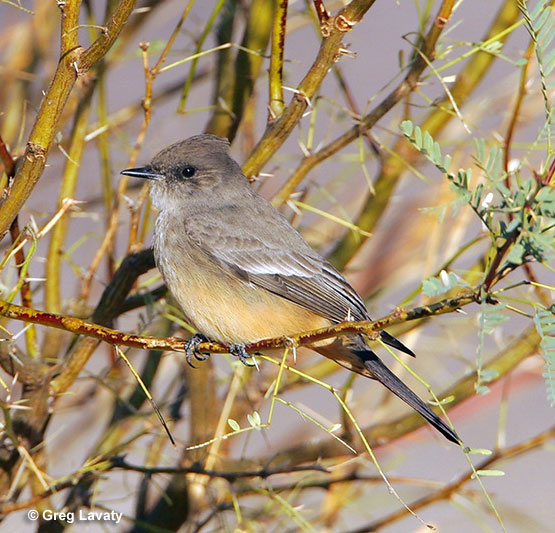
Scientific name: Sayornis saya
Length: 7.5 inches
Weight: .74 ounces
Wingspan: 13 inches
Song: “pidi deeeer pidi deeeer pidi deeer pdip!”
The Say’s Phoebe is a thrush-sized, plain grayish flycatcher with a salmon-colored belly and undertail. Both sexes look alike and have a longish, black tail, and long, dark wings with gray edging.
Young birds resemble adults but are paler and have tawny wing bars and edging to the feathers in their wings.
This species feeds on a variety of flying and terrestrial insects in open habitats. It catches food items by flying from a low perch and snatching them in the air, and also from the ground. It also forages by hovering and dropping to catch bugs on the ground, especially in cool weather.
The Say’s Phoebe uses grass, moss, other plant matter, spiderwebs, and other items to make a platformed cup nest built on ledge or other hard structure. Such structures can include buildings, bridges, and rock walls.
Say’s Phoebes live in a variety of open habitats in Alaska, western Canada, the western USA, and Mexico.
Key Identifications:
- A soft grayish, thrush-sized flycatcher with a salmon-colored belly and undertail, and long black tail.
- Sallies and hovers to catch insects in flight and on the ground.
- Makes a platformed cup nest out of moss, grass, and other materials and builds it on the ledge of a rock wall or other hard surface.
- Sings brief, repeated whistled notes, “pidi deeeer pidi deeeer pidi deeer pdip!”.
The Say’s Phoebe is a thrush-sized, grayish and salmon-colored flycatcher of open habitats. This bird is usually seen alone, sitting on a prominent perch. This species breeds further north than any other member of the flycatcher family, even living in tundra and nesting on Arctic pipelines.
Mallard
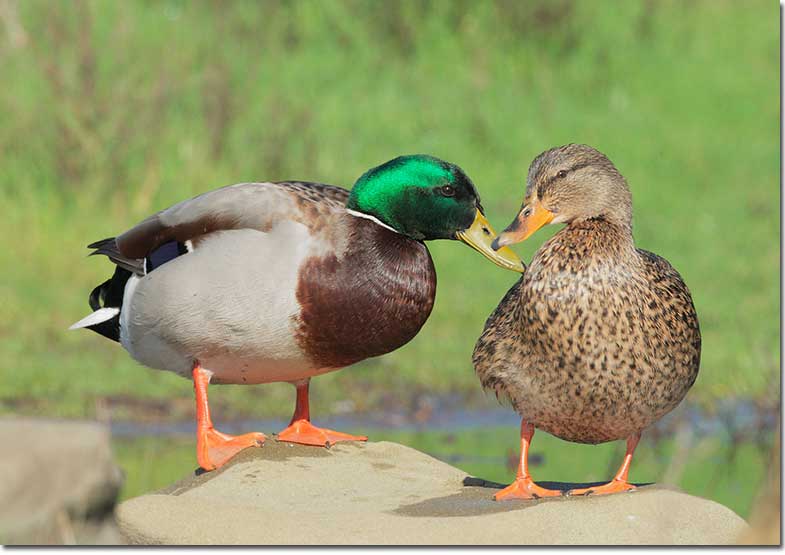
Mallard pair (Male and female)
Scientific name: Anas platyrhynchos
Length: 23 inches
Weight: 2.4 pounds
Wingspan: 35 inches
Song: “quack, quack”
The Mallard is a fairly large, familiar duck. The male has a metallic green head, yellow bill, narrow white ring around the neck, and chestnut breast. The rest of the bird is pale gray with pale brown, and black on its back and around his tail.
Female Mallards are mottled brown and buff with a dark crown and line through the eyes, and have a dark gray and orange beak.
In flight, both sexes show a green-blue wing patch bordered with white.
Mallards eat a variety of items including insect larvae, snails, other small aquatic creatures, acorns, seeds, and grain. They forage by filtering and picking up food items in and near shallow water, and in farm fields.
This New Mexico duck species makes a shallow nest with sticks and lined with down feathers. It builds its nest on the ground, hidden in grass or under a bush.
The Mallard lives in ponds, marshes, and many wetland habitats in Canada, USA, and Eurasia.
Key Identifications:
- Feeds on insect larvae, grain, seeds, and other items picked up with its bill in and near shallow water.
- Makes a shallow stick nest hidden in grass or under a bush.
- The female Mallard makes the classic “quack, quack” duck sound. Males make similar but softer sounds and a whistling call.
The Mallard is a fairly large and familiar duck with a dark green head (the male), or is buff and brown with a dark gray and orange beak (the female). Thus duck species often lives near people and occurs on lakes, ponds, and other wetlands. No matter how different they look, most small domestic duck species are descended from wild Mallards.
Eurasian Collared-Dove
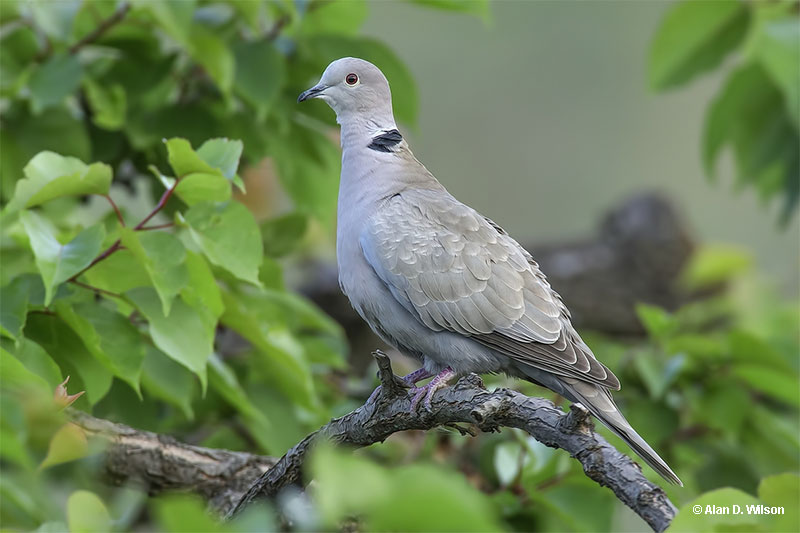
Scientific name: Streptopelia decaocto
Length: 13 inches
Weight: 7 ounces
Wingspan: 22 inches
Song: “hoo hoo hoowuh hoo WUH hoowuh hoo WUH!”
The Eurasian Collared-Dove is a medium to large, pale tan and gray dove with a black mark on its nape. Males and females look similar, have a slender black beak, and a narrow gray eyering.
Eurasian Collared-Doves have black primaries and white in their tail feathers. These field marks are especially visible in flight.
These doves feed on grain and seeds picked from the ground and they can also visit feeders. In some places, Eurasian Collared-Doves occur in large flocks, especially around farms and grain silos.
The Eurasian Collared-Dove makes messy stick nests in trees and on structures near people. This species is highly adapted to living with and near people and prefers to feed in farm fields, gardens, towns, and other places where they can find grain and seeds.
This Eurasian species was accidentally introduced to North America in the 1970s and 1980s. It now occurs in parts of Alaska and much of Canada and the USA, including New Mexico.
Key Identifications:
- Fairly large, pale tan and gray dove with black primaries and white in its longish tail.
- Forages for grain and seeds on the ground.
- Makes messy stick nests in gardens, parks, and on farms.
- This dove species often calls and makes a typical dove-like sound, “hoo hoo hoowuh hoo WUH hoowuh hoo WUH!”.
The Eurasian Collared-Dove is a fair-sized pale tan and gray dove with much white in its longish tail. These birds can probably only survive near people and live in gardens, towns, and on farms. When drinking water, this species uses its beak like a straw.
Black-chinned Hummingbird
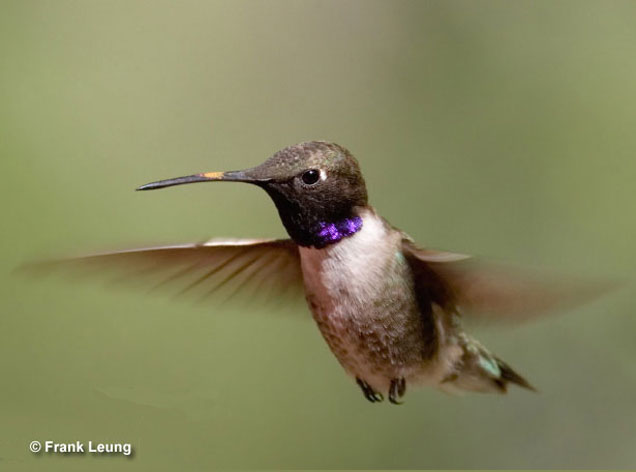
Scientific name: Archilochus alexandri
Length: 3.75 inches
Weight: .12 ounces
Wingspan: 4.75 inches
Song: “reet reet reet reet reet”
The Black-chinned Hummingbird is a small hummingbird with a green back, small white spot behind the eye, and a long, slightly curved beak.
The male has a black chin, dark purple throat, and gray-green underparts with a white semi-collar. He also has a black, slightly forked tail.
The female Black-chinned Hummingbird has mostly pale gray underparts. Her tail also has a black and white tip. Young birds resemble females but have more gray on their head, and can show small purple spots on their throat.
Black-chinned Hummingbirds catch small bugs in flight and drink nectar from flowers in a variety of habitats. They live in gardens, canyons, riparian zones, and other places from southern British Columbia to central Texas and northern Mexico.
This species makes a tiny cup nest out of soft plant fibers, spider webs, and cocoons. It builds it in a tree, often near water, around six feet above the ground.
Key Identifications:
- Small hummingbird with a long, slightly curved beak, small spot behind the eye, dark throat (male), or a grayish throat and black and white in the tail (female).
- Catches small bugs and drinks nectar from flowers and feeders.
- Builds a tiny cup nest out of spider webs, soft plant material, and cocoons.
- Sings a repeated “reet reet reet reet reet”, and makes other chattering and twittering sounds.
The Black-chinned Hummingbird is a small hummingbird with a long, slightly curved beak, and a dark or gray throat. It lives in gardens, canyons, and many other dry habitats. This species extends its tongue to drink nectar at a rate of 13-17 licks per second!
Yellow-rumped Warbler
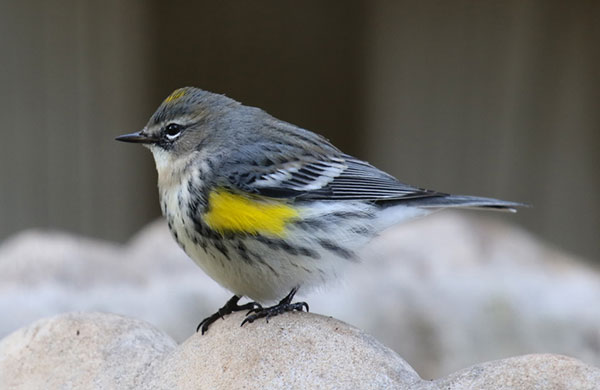
Scientific name: Setophaga coronata
Length: 5.5 inches
Weight: .42 ounces
Wingspan: 9.25 inches
Song: “si,sit,sit,sit,sit,sue,sue,sue”
The Yellow-rumped Warbler is a small, blue-gray songbird with a yellow rump, crown, and yellow patches on each side of its breast. It also has two white wing bars, dark marks on the back, and white underparts with blackish markings on its breast and sides.
In summer, this species has a blackish face and white markings above and below the eyes. Females are like males but duller. In winter, both sexes of Yellow-rumped Warblers are duller and have more brownish plumage.
The western subspecies has a yellow throat and more white in the wings.
This species feeds on insects and small berries. It picks food from vegetation and briefly flies into the air to catch bugs in flight.
Yellow-rumped Warbler build small cup nests in conifers in Canada and the northeastern and western USA. They spend the winter in semi-open habitats from the southern USA to Central America.
Key Identifications:
- Small songbird with two pale wing bars and yellow patches on the rump, each side of its breast, and crown.
- Feeds on insects and small berries.
- Builds cup nests in conifers in northern and montane forests.
- The Yellow-rumped Warbler makes a sharp call note, “chup!”, and sings a brief and easy-going warbling song, “si,sit,sit,sit,sit,sue,sue,sue”.
Yellow-rumped Warblers are small, blue-gray or brownish songbirds with two pale wing bars, and yellow patches on the crown, sides of the breast, and rump. In winter, they occur in small flocks that feed on insects and berries in parks and other semi-open habitats. The eastern subspecies is known as the “Myrtle Warbler” and the yellow-throated western subspecies is called, “Audubon’s Warbler”.
Red-winged Blackbird
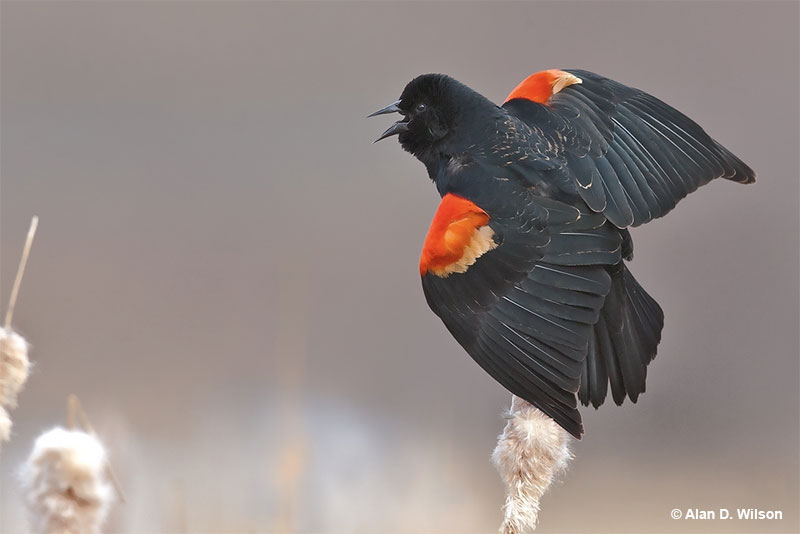
Scientific name: Agelaius phoeniceus
Length: 8.75 inches
Weight: 1.8 ounces
Wingspan: 13 inches
Song: “kan-keree!”
The Red-winged Blackbird is a medium-sized blackbird species with a sharp, all black bill. Males also have a scarlet patch with a pale yellow border on the shoulder of each wing.
Female Red-winged Blackbirds are dark, heavily streaked, brownish-gray birds with an orange-buff eyebrow and throat. She can also have a little bit of dingy red on her shoulder.
Red-winged Blackbirds often flock together and can form very large groups in the winter. They feed on seeds, grain, and insects found on lawns, in marshes, farm fields, and other open habitats.
This species builds a cup nest made of leaves and dead stems in a bush or other low vegetation in a marsh, park, or brushy field.
Red-winged Blackbirds are very common birds that live in all sorts of open habitats. We see them in parks, farming areas, and marshes in much of Canada, the USA, Mexico, and parts of the Central America.
Key Identifications:
- Males are medium-sized blackbirds with a bright red patch on their wings. Females are heavily streaked, have a sharp black beak, and buff on the head.
- Feeds on seeds, grain, and insects on the ground in many open habitats.
- Builds a cup nest in a bush or other low vegetation.
- Red-winged Blackbirds often call. Males sing a loud, “kan-keree!” and both sexes also make “check!” calls and a high-pitched whistle-like sound.
The Red-winged Blackbird is a common, social species easily seen in marshes and open habitats. In the winter, it can form huge flocks that feed in farm fields. This species can make a daily commute of 50 miles to and from roosting and feeding sites.
Ladder-backed Woodpecker
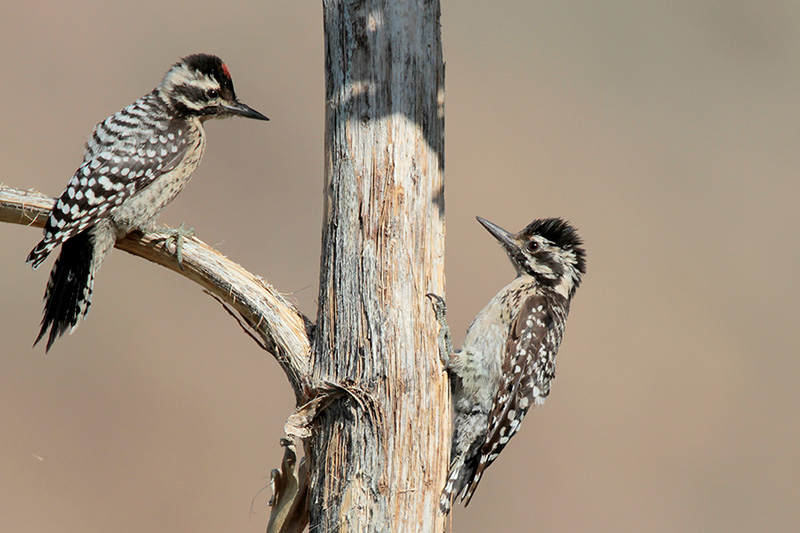
Scientific name: Dryobates scalaris
Length: 7.25 inches
Weight: 1.1 ounces
Wingspan: 13 inches
Song: “pik pikikikikikikiki”
The Ladder-backed Woodpecker is a small black and white woodpecker with a dark, straight beak and black and white, barred upperparts. It also has two thick black lines on its pale face, and some black streaks and markings on buff underparts.
Both sexes look similar but males have a red crown. Young birds of both sexes have a smaller amount of red on their head.
This species feeds on insects and other arthropods. It finds these food items by tapping into branches and trunks of cactus and arid vegetation. This bird can also visit feeders that have suet.
The Ladder-backed Woodpecker excavates a nesting hole in oaks, pines, wooden posts, Mesquite, and various types of arid vegetation.
This small woodpecker lives in a variety of arid and edge habitats in parts of the American southwest, much of Texas, much of Mexico, and parts of Central America. They are common in New Mexico.
Key Identifications:
- Small black and white woodpecker of arid habitats with barred upperparts.
- Forages for insects and other small creatures in arid vegetation and edge habitats.
- Excavates nesting holes in wooden posts, cactus, and arid vegetation.
- Makes sharp “pik!” notes and a dry rattle, “pik pikikikikikikiki”.
The Ladder-backed Woodpecker is a small woodpecker of arid habitats with black and white barred upperparts. Pairs forage in edge and arid habitats and can visit feeders for suet. This species is so tied to arid habitats that it used to be known as the “Cactus Woodpecker”.
Rock Pigeon
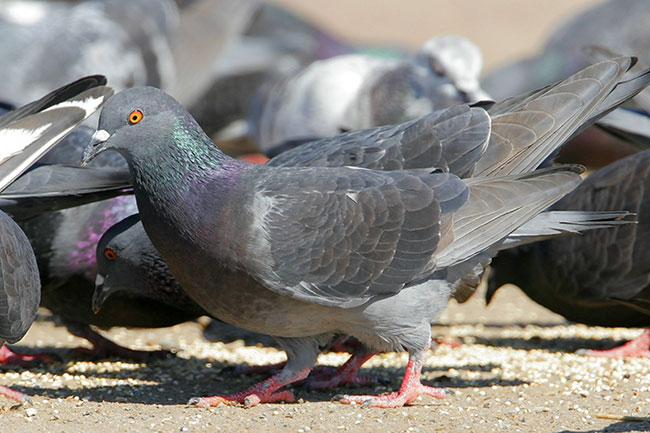
Scientific name: Columba livia
Length: 12.5 inches
Weight: 9 ounces
Wingspan: 28 inches
Song: “tititik grewh”
The Rock Pigeon is the familiar and common “pigeon” of cities, farms, and other urban situations. Although this pigeon can show a variety of plumages, the most frequent one is pale gray with dark gray on the head and neck, and a dark gray tail with a dark tip.
It also has iridescent green on its neck and two black wing bars.
This species has quick and direct flight with rapidly beating wings.
Rock Pigeons usually occur in flocks and large ones can form in farm fields and some urban areas. They pick seeds and grain from the ground, mostly in open areas like farm fields, parks, and city streets.
The Rock Pigeon uses sticks and other stick-like objects to make a shallow nest on covered ledges of buildings and other structures.
Rock Pigeons are completely adapted to living with people and occur in urban and farming areas in most parts of North America, including New Mexico.
Key Identifications:
- Familiar gray pigeon with dark tip at the end of its tail and two black wing bars.
- Picks seeds and grain from the ground of streets, fields, and other open habitats.
- Makes messy stick nests on ledges with overhanging structures.
- Makes a gruffy vocalization, “tititik grewh”.
This species is the common and familiar city pigeon. Rock Pigeons are darker than other doves and feed on the ground in farm fields and streets. Truly wild Rock Pigeons are shy and only live on remote cliffs in Europe and Asia.
Turkey Vulture
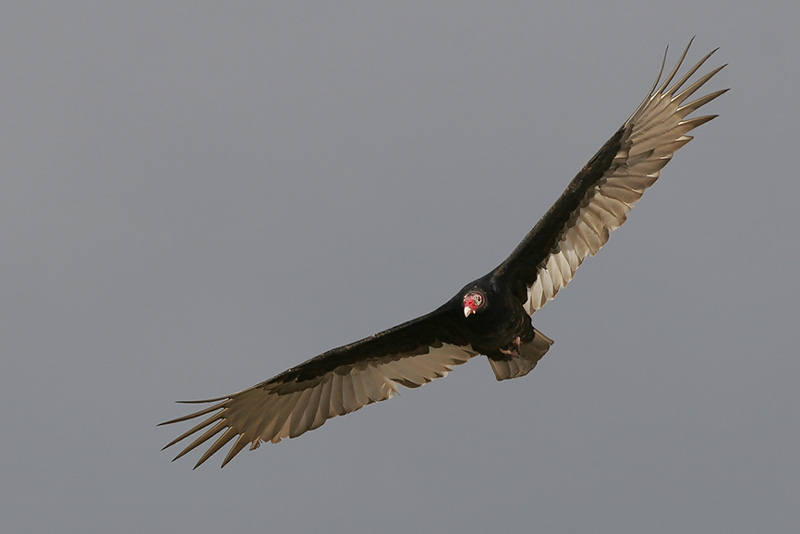
Scientific name: Cathartes aura
Length: 26 inches
Weight: 4 pounds
Wingspan: 67 inches
Song: “hisss”
The Turkey Vulture is a big, dark brownish-black raptor with a small red head and long, broad wings. Males and females look alike and also have a longish tail.
In flight, the way Turkey Vultures soar is one of the best ways to recognize them. They fly with their wings held in a V shape and, when gliding, often rock back and forth.
Their flight feathers are also paler than the rest of their wings but they lack the Black Vulture’s white wing patch.
Turkey Vultures are scavengers, and most of their diet is carrion. They eat road kill and a wide variety of dead animals. This species forages over every type of habitat and can also fly over urban areas.
It lays two eggs on the ground in caves and hollow logs.
The Turkey Vulture lives in southern Canada and in most of the USA south to southern Argentina.
Key Identifications:
- Big, dark raptor with a small red head that soars with long wings held in a V.
- Feeds on dead animals.
- Nests on the ground in caves and hollow logs in secluded areas.
- Turkey Vultures rarely call and mostly make hissing sounds at their nest.
The Turkey Vulture is commonly seen flying over every type of habitat. They are often seen on their own but can occur in flocks, especially during migration. Unlike most other birds, this species uses its amazing sense of smell to find dead animals.
Canada Goose
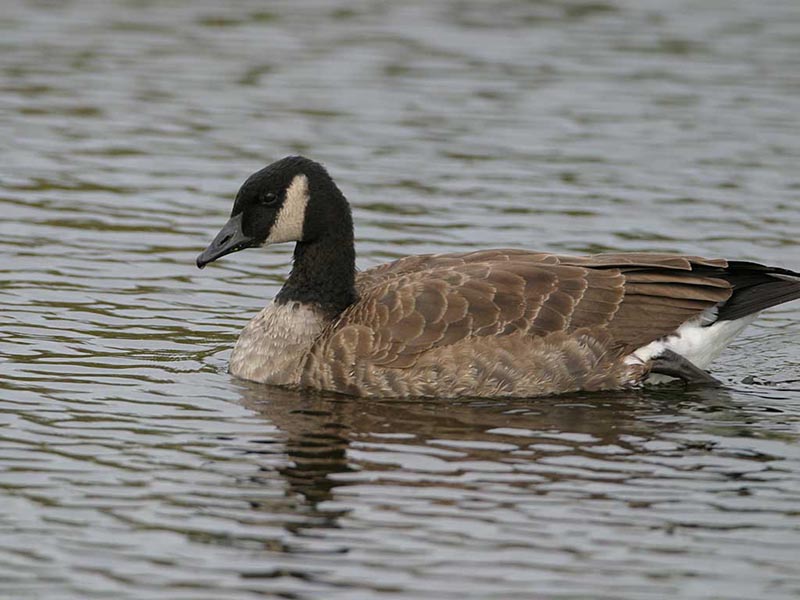
Scientific name: Branta canadensis
Length: 35 – 45.2 inches
Weight: 5.29 – 19.8 pounds
Wingspan: 50 – 67 inches
Song: “uurrRUNK! uurrRUNK!”
The Canada Goose is a large, grayish-brown bird with a long black neck, and black head with a white throat and cheeks. Males and females look alike and have pale barring, a white belly and undertail, and a short black and white tail.
They have strong direct flight and make deep flaps with long, broad wings.
Canada Geese feed on grass, sedges, and other vegetation, grain, and berries. They forage by walking along and grazing, or picking food from the ground and bushes. This species also feeds by dipping its head below the surface of shallow water.
This large goose uses grass and other plants to make a large, shallow cup nest on a small mound or other elevated spot next to water.
The Canada Goose prefers open grassy areas and farm fields near water where it can feed and see predators before they get too close. They live in Alaska, most of Canada, and most of the USA, being one of the most common birds of New Mexico.
Key Identifications:
- Big, gray-brown goose with a long black neck, and black and white head.
- Grazes vegetation and forages for berries in wide open, grassy habitats near water like golf courses, parks, and airports.
- Makes a shallow, open cup nest on an elevated spot next to water.
- Vocal and often makes honking calls, “uurrRUNK! uurrRUNK!”.
Canada Geese are a large, common goose species with long black necks, and a black and white head. These big birds are a common sight on golf courses and other places that combine open lawns and water. When the Canada Goose and other birds migrate in V formation, they expend less energy than flying on their own.
Western Bluebird
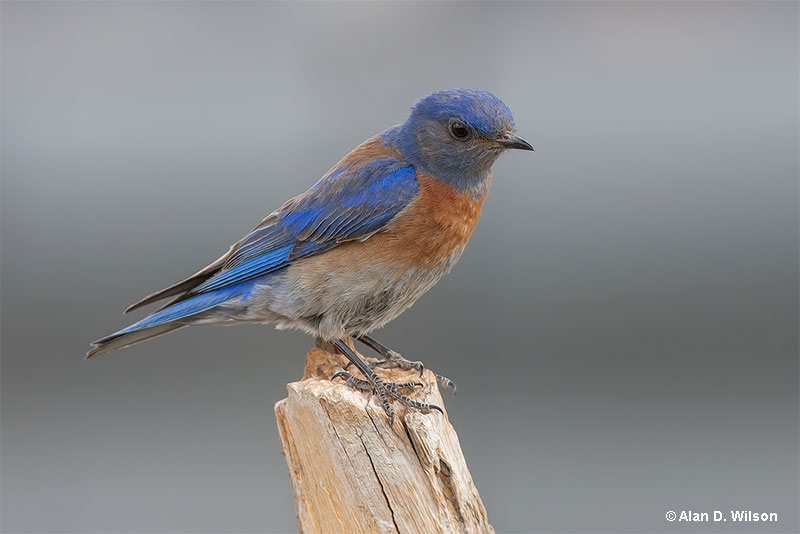
Scientific name: Sialia mexicana
Length: 7 inches
Weight: 1 ounces
Wingspan: 13.5 inches
Song: “fer fer chidip fer”
The Western Bluebird is a smallish, beautiful blue and gray bird with a chestnut patch on its back and deep pumpkin orange on its breast and upper flanks. The male has a deep blue head, back, wings, and tail while females are paler, grayer, and have a white eyering.
Young birds are more gray-brown with pale spotting. This species also has long wings that it uses for quick, swooping flight.
The Western Bluebird feeds on insects, small fruit, and some seeds. It catches insects in flight, by picking them from foliage, and by swooping down into meadows and catching them on the ground.
They feed on berries and other small fruits by picking them from vegetation while they are perched. You can also see Western Bluebirds in your backyard.
Western Bluebirds build a shallow cup nest out of grass inside a tree cavity.
These beautiful birds live in pine and oak woodlands with meadows in south-central British Columbia and various parts of the western USA south to Mexico.
Key Identifications:
- Smallish blue and gray bird with chestnut on their back and deep orange on their breast and flanks.
- Feeds on insects and small fruits.
- Makes a shallow cup nest out of grass in a tree cavity.
- Makes short calls, “fer fer chidip fer”.
The Western Bluebird is a smallish, blue and gray bird with deep orange highlights. They live in semi-open woodlands and, in winter, form flocks that visit fruiting trees. Western Bluebirds are cooperative breeders that can help feed each other’s young.
Birds of New Mexico – Frequently Asked Questions
How many species of birds live in New Mexico?
Many birds live in New Mexico. In total, 551 species of birds are on the state list!
What is the blue bird in New Mexico?
The blue bird in New Mexico could be the Mountain Bluebird. Males of this species have beautiful sky-blue plumage and live in many parts of the state. Some other blue birds in Mexico are the Woodhouse’s Scrub-Jay, Steller’s Jay, Western Bluebird, and the Blue Grosbeak.
What are the bosque birds in Albuquerque?
The bosque birds in Albuquerque are the Cooper’s Hawk, Greater Roadrunner, Sandhill Crane, and various other species that live in the Cottonwood riparian zones or ‘bosques” found in and near the city.
What is the state bird of New Mexico for kids?
The Greater Roadrunner is the state bird of New Mexico. This official state bird is common in many parts of New Mexico and is even an urban bird in some areas.

